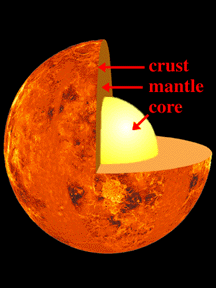From our perspective here on Earth, Venus is completely covered in clouds. So what’s inside Venus? For most of history, scientists had no idea what’s inside of Venus. The earliest telescopes showed hazy cloud tops, and even the largest telescopes didn’t improve the view. Some astronomers thought they might have caught a glimpse of the surface through the clouds, or maybe the peak of a tall mountain poking up through the clouds. But we now know those were just observation errors.
It wasn’t until the first spacecraft from Earth arrived at Venus, and started gathering scientific data about the inside of Venus. NASA’s Mariner 2 helped scientists calculate that the density of Venus is very similar to the density of Earth. Although there were no direct observations of Venus’ interior, scientists assume that it must be similar to Earth. The inside of Venus is thought to contain a solid/liquid core of metal 3,000 km across. This is surrounded by a mantle of rock 3,000 km thick. And then there’s a thin crust of rock about 50 km thick.
When NASA’s Magellan spacecraft was launched to Venus in 1989, it was carrying a suite of powerful radar mapping instruments. These tools could pierce through the thick clouds surrounding Venus and reveal the surface of the planet in great detail. Magellan found that the surface of Venus is actually quite young, and was probably resurfaced 300-500 million years ago, based on the number of impact craters found on its surface.
Magellan also found evidence of a large number of volcanoes; they number in the thousands and maybe even in the millions. The shield volcanoes found across the surface of Venus indicate that the inside of Venus is still active, with magma pushing to the surface around the planet.
It’s believed that the event that resurfaced Venus 300-500 million years ago might have also shut down plate tectonics on Venus. Without the movement of plates to release trapped heat, the inside of Venus remained much hotter than it would be. It’s thought that this increase in heat also shut down the convection of metal around the core of Venus. It’s this convection in the Earth’s core that’s thought to run our planet’s magnetic field.
We have written many articles about Venus for Universe Today. Here’s an article about Venus’ wet, volcanic past, and here’s an article about how Venus might have had continents and oceans in the ancient past.
Want more information on Venus? Here’s a link to Hubblesite’s News Releases about Venus, and here’s NASA’s Solar System Exploration Guide to Venus.
We have recorded a whole episode of Astronomy Cast that’s only about planet Venus. Listen to it here, Episode 50: Venus.
References:
NASA Solar System Exploration: Terrestrial Planets
Venus Interior

